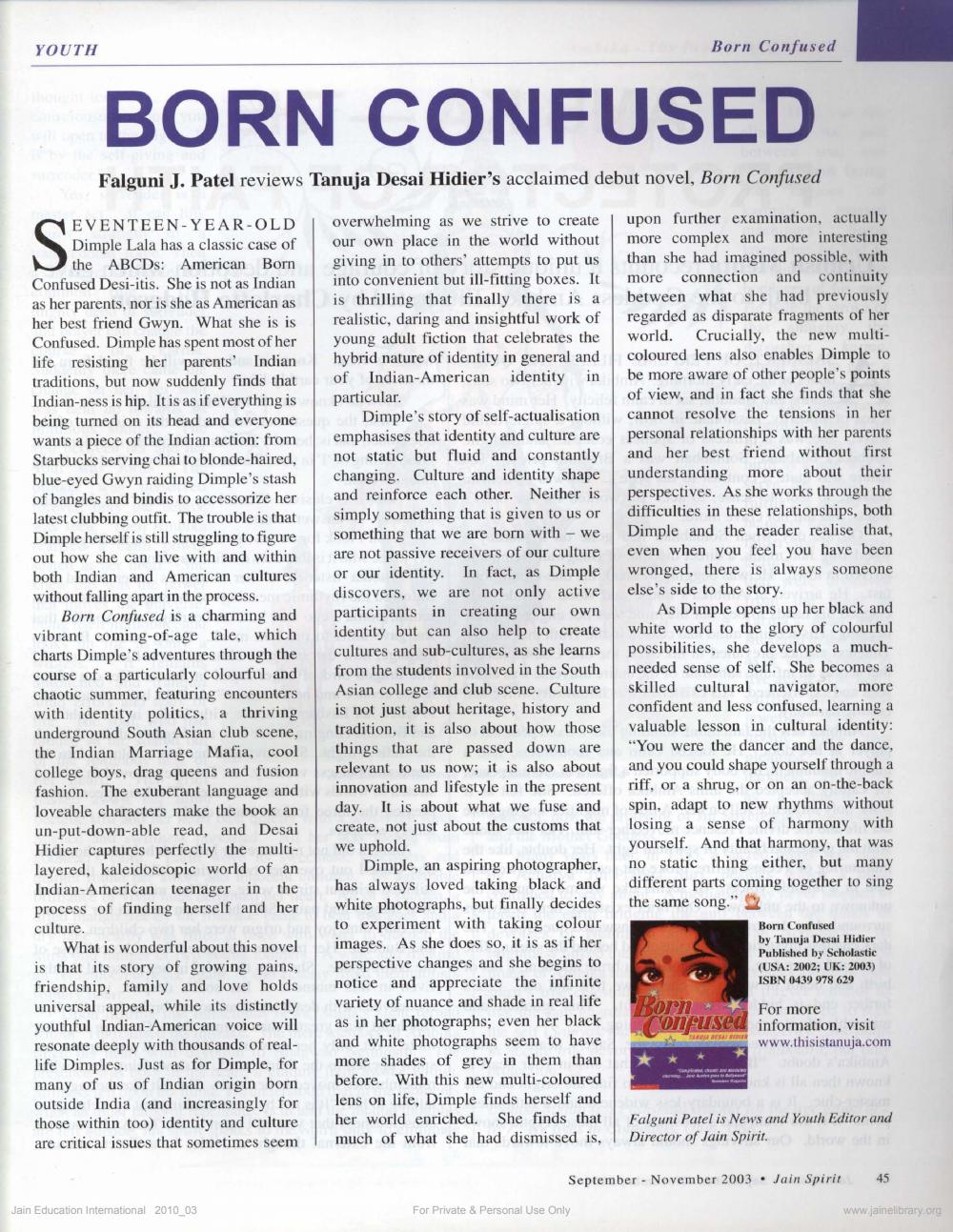________________
YOUTH
Born Confused
BORN CONFUSED
Falguni J. Patel reviews Tanuja Desai Hidier's acclaimed debut novel, Born Confused
EVENTEEN-YEAR-OLD Dimple Lala has a classic case of
the ABCDs: American Born Confused Desi-itis. She is not as Indian as her parents, nor is she as American as her best friend Gwyn. What she is is Confused. Dimple has spent most of her life resisting her parents' Indian traditions, but now suddenly finds that Indian-ness is hip. It is as if everything is being turned on its head and everyone wants a piece of the Indian action: from Starbucks serving chai to blonde-haired, blue-eyed Gwyn raiding Dimple's stash of bangles and bindis to accessorize her latest clubbing outfit. The trouble is that Dimple herself is still struggling to figure out how she can live with and within both Indian and American cultures without falling apart in the process.
Born Confused is a charming and vibrant coming-of-age tale, which charts Dimple's adventures through the course of a particularly colourful and chaotic summer, featuring encounters with identity politics, a thriving underground South Asian club scene, the Indian Marriage Mafia, cool college boys, drag queens and fusion fashion. The exuberant language and loveable characters make the book an un-put-down-able read, and Desai Hidier captures perfectly the multilayered, kaleidoscopic world of an Indian-American teenager in the process of finding herself and her culture.
What is wonderful about this novel is that its story of growing pains, friendship, family and love holds universal appeal, while its distinctly youthful Indian-American voice will resonate deeply with thousands of reallife Dimples. Just as for Dimple, for many of us of Indian origin born outside India (and increasingly for those within too) identity and culture are critical issues that sometimes seem
overwhelming as we strive to create our own place in the world without giving in to others' attempts to put us into convenient but ill-fitting boxes. It is thrilling that finally there is a realistic, daring and insightful work of young adult fiction that celebrates the hybrid nature of identity in general and of Indian-American identity in particular.
Dimple's story of self-actualisation emphasises that identity and culture are not static but fluid and constantly changing. Culture and identity shape and reinforce each other. Neither is simply something that is given to us or something that we are born with - We are not passive receivers of our culture or our identity. In fact, as Dimple discovers, we are not only active participants in creating our own identity but can also help to create cultures and sub-cultures, as she learns from the students involved in the South Asian college and club scene. Culture is not just about heritage, history and tradition, it is also about how those things that are passed down are relevant to us now; it is also about innovation and lifestyle in the present day. It is about what we fuse and create, not just about the customs that we uphold.
Dimple, an aspiring photographer, has always loved taking black and white photographs, but finally decides to experiment with taking colour images. As she does so, it is as if her perspective changes and she begins to notice and appreciate the infinite variety of nuance and shade in real life as in her photographs; even her black and white photographs seem to have more shades of grey in them than before. With this new multi-coloured lens on life, Dimple finds herself and her world enriched. She finds that much of what she had dismissed is,
upon further examination, actually more complex and more interesting than she had imagined possible, with more connection and continuity between what she had previously regarded as disparate fragments of her world. Crucially, the new multicoloured lens also enables Dimple to be more aware of other people's points of view, and in fact she finds that she cannot resolve the tensions in her personal relationships with her parents and her best friend without first understanding more about their perspectives. As she works through the difficulties in these relationships, both Dimple and the reader realise that, even when you feel you have been wronged, there is always someone else's side to the story
As Dimple opens up her black and white world to the glory of colourful possibilities, she develops a muchneeded sense of self. She becomes a skilled cultural navigator, more confident and less confused, learning a valuable lesson in cultural identity: "You were the dancer and the dance, and you could shape yourself through a riff, or a shrug, or on an on-the-back spin, adapt to new rhythms without losing a sense of harmony with yourself. And that harmony, that was no static thing either, but many different parts coming together to sing the same song."
Born Confused by Tanuja Desai Hidier Published by Scholastic (USA: 2002; UK: 2003) ISBN 0439 978 629
For more confused information, visit
www.thisistanuja.com * *
Falguni Patel is News and Youth Editor and Director of Jain Spirit.
September - November 2003 . Jain Spirit
45
Jain Education Interational 2010_03
For Private & Personal Use Only
www.jainelibrary.org




